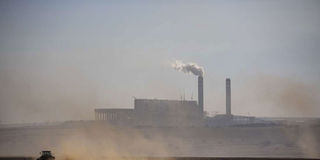Why the air is cleaner amid coronavirus outbreak

The increase of two pollutants — nitrogen dioxide and carbon dioxide — has slowed down since the outbreak of coronavirus. PHOTO | AFP
The increase of two pollutants — nitrogen dioxide and carbon dioxide — has slowed down. Thanks to lockdowns imposed by governments in a bid to curb the spread of the disease, the levels of the two gases have gone down, a report shows.
Carbon dioxide is a major greenhouse gas (GHG) which contributes to global warming and climate change, which affect millions of people, including Kenyans who have had to endure droughts, floods and diseases.
While nitrogen dioxide is emitted by vehicles, industries and power plants, carbon dioxide emissions come from burning of organic matter, respiration and burning of fossil fuels for generation of power and vehicles.
Although, nitrogen dioxide is not a greenhouse gas despite the fact that it originates from the same activities responsible for carbon emissions, it contributes to the formation of ozone — a greenhouse gas, just like nitrogen oxides which are emitted by aeroplanes.
Unfortunately, nitrogen oxide exacerbates asthma and other respiratory diseases. It is a gas the World Health Organization states as “toxic”.
It leads to inflammation of airways if its concentration is higher than 200 micrograms per cubic metres, according to the WHO.
Major cities across the world have been on lockdown including Wuhan, the source of the Covid-19.
LESS TRAFFIC
Many of these cities and towns are industrial and commercial. It means economic activities, which include manufacturing and transportation, have been halted.
People have been forced to stay indoors. Currently, more than one billion people (with India under a total lockdown) have been ordered to stay or work from home as governments accelerate measures to prevent the spread of Covid-19. This means less traffic (on land, air and sea) and less industrial activity.
Major airlines have suspended flights to and from most countries affected by the disease, including Kenya Airways which grounded operations last week as more cases of coronavirus disease continue to be confirmed in Kenya.
Many airlines stopped flights to Italy, the new epicentre of Covid-19, weeks after many flights to mainland China and especially Wuhan were suspended.
Aeroplanes are major emitters of greenhouse gases, which include carbon dioxide and nitrogen oxides.
Currently, the US, where about 40 per cent of the population is affected by lockdowns and restrictions, is responsible for almost half of global carbon dioxide emissions from aircraft, but has also seen a reduction in daily flights.
Amid the spread of the coronavirus globally, flights were gradually reduced from an average of 170,000 per day to 94,477 by Wednesday last week, according to Flighradar24.
This has resulted in a significant reduction of carbon dioxide and nitrogen oxide in the atmosphere, according to research.
On the other hand, fossil fuels are used during power generation, manufacturing and in road transport and result in greenhouse gases emissions.
Since the lockdowns, these activities, main contributors to air pollution and GHGs, have reduced significantly. The lockdowns started in Wuhan, a populous city of at least 11 million people, in Hubei Province of China and have since spread across the globe.
During a recent interview, Dr John Mumbo, the Principal Compliance and Enforcement Officer at the National Environment and Management Authority (Nema) said: “The air quality is good out of the urban areas. In the cities, the quality is average, but slowly deteriorating due to increased vehicular and industrial emissions. The level of pollution is higher at dumpsites, specific industries that emit and on roads with high traffic congestion.”
This statement corroborates the current situation where satellite images taken by National Aeronautics and Space Administration (Nasa) show that during China’s lockdown, the level of nitrogen dioxide had reduced significantly.
The level of nitrogen dioxide was assessed from January 1 to February 25. Compared to the same period in 2019, the levels of the gas were much lower, which scientists have attributed to the lockdown occasioned by efforts to stop the spread of coronavirus disease.
This year, the levels were dramatically too low, according to the observation. Nasa compared the average nitrogen dioxide level, which was detected between 2005 and 2019 in the same period an 2020, and found out that the gas in 2020 had been lowered by between 10 to 30 per cent in eastern and central China.
According to research analysis by Carbon Brief, “over the same period in 2019, China released around 800m tonnes of CO2, meaning the virus could have cut global emissions by 200 metric tonnes to date”.
The same is happening in the US, Europe and Asia. According to Severe Weather Europe, “it is getting obvious that the carbon dioxide levels are increasing at a much slower rate than expected. It looks almost like the carbon dioxide levels have stopped increasing for the time being”.
While the slowdown of the increase in GHGs and pollutants due to Covid-19 may be a blessing in disguise, it cannot substitute the long term efforts to bring down global warming, said the World Meteorological Organisation.
Currently, satellite data by Nasa show that Greenland and Antarctica are losing mass at a rate of 283 gigatonnes per year and 145 gigatonnes per year respectively, meaning more flooding along the coastal areas.


